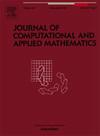Adaptive finite element method for phase field fracture models based on recovery error estimates
IF 2.1
2区 数学
Q1 MATHEMATICS, APPLIED
Journal of Computational and Applied Mathematics
Pub Date : 2025-05-28
DOI:10.1016/j.cam.2025.116732
引用次数: 0
Abstract
The phase-field model is a widely used mathematical approach for describing crack propagation in continuum damage fractures. In the context of phase field fracture simulations, adaptive finite element methods (AFEM) are often employed to address the mesh size dependency of the model. However, existing AFEM approaches for this application frequently rely on heuristic adjustments and empirical parameters for mesh refinement. In this paper, we introduce an adaptive finite element method based on a recovery type posteriori error estimates approach grounded in theoretical analysis. This method transforms the gradient of the numerical solution into a smoother function space, using the difference between the recovered gradient and the original numerical gradient as an error indicator for adaptive mesh refinement. This enables the automatic capture of crack propagation directions without the need for empirical parameters. We have implemented this adaptive method for the Hybrid formulation of the phase-field model using the open-source software package FEALPy. The accuracy and efficiency of the proposed approach are demonstrated through simulations of classical 2D and 3D brittle fracture examples, validating the robustness and effectiveness of our implementation.
基于恢复误差估计的相场裂缝模型的自适应有限元方法
相场模型是描述连续损伤断裂中裂纹扩展的一种广泛使用的数学方法。在相场断裂模拟中,通常采用自适应有限元方法(AFEM)来解决模型的网格尺寸依赖性问题。然而,用于此应用的现有AFEM方法经常依赖启发式调整和经验参数来进行网格细化。本文在理论分析的基础上,提出了一种基于恢复型后验误差估计方法的自适应有限元方法。该方法将数值解的梯度转换为更平滑的函数空间,利用恢复的梯度与原始数值梯度的差值作为自适应网格细化的误差指标。这使得裂纹扩展方向的自动捕获不需要经验参数。我们利用开源软件包FEALPy实现了相场模型混合公式的自适应方法。通过经典二维和三维脆性断裂实例的仿真验证了该方法的准确性和有效性,验证了该方法的鲁棒性和有效性。
本文章由计算机程序翻译,如有差异,请以英文原文为准。
求助全文
约1分钟内获得全文
求助全文
来源期刊
CiteScore
5.40
自引率
4.20%
发文量
437
审稿时长
3.0 months
期刊介绍:
The Journal of Computational and Applied Mathematics publishes original papers of high scientific value in all areas of computational and applied mathematics. The main interest of the Journal is in papers that describe and analyze new computational techniques for solving scientific or engineering problems. Also the improved analysis, including the effectiveness and applicability, of existing methods and algorithms is of importance. The computational efficiency (e.g. the convergence, stability, accuracy, ...) should be proved and illustrated by nontrivial numerical examples. Papers describing only variants of existing methods, without adding significant new computational properties are not of interest.
The audience consists of: applied mathematicians, numerical analysts, computational scientists and engineers.

 求助内容:
求助内容: 应助结果提醒方式:
应助结果提醒方式:


